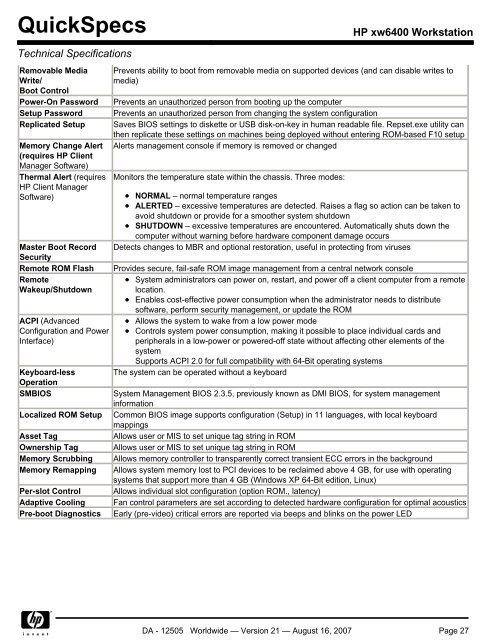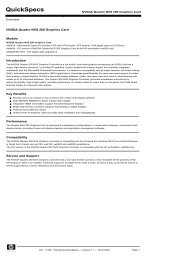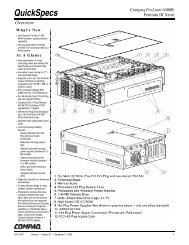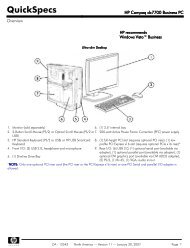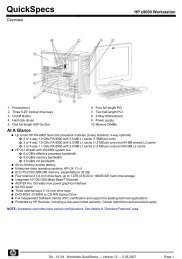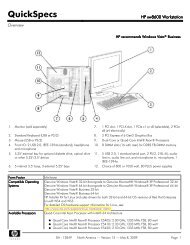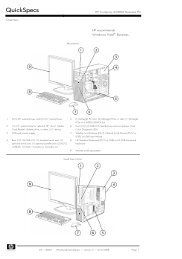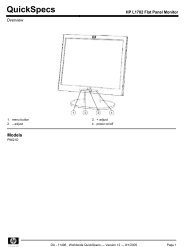HP xw6400 Workstation - Nts
HP xw6400 Workstation - Nts
HP xw6400 Workstation - Nts
Create successful ePaper yourself
Turn your PDF publications into a flip-book with our unique Google optimized e-Paper software.
QuickSpecs<br />
<strong>HP</strong> <strong>xw6400</strong> <strong>Workstation</strong><br />
Technical Specifications<br />
Removable Media<br />
Write/<br />
Boot Control<br />
Power-On Password<br />
Setup Password<br />
Replicated Setup<br />
Memory Change Alert<br />
(requires <strong>HP</strong> Client<br />
Manager Software)<br />
Thermal Alert (requires<br />
<strong>HP</strong> Client Manager<br />
Software)<br />
Master Boot Record<br />
Security<br />
Remote ROM Flash<br />
Remote<br />
Wakeup/Shutdown<br />
ACPI (Advanced<br />
Configuration and Power<br />
Interface)<br />
Keyboard-less<br />
Operation<br />
SMBIOS<br />
Localized ROM Setup<br />
Asset Tag<br />
Ownership Tag<br />
Memory Scrubbing<br />
Memory Remapping<br />
Per-slot Control<br />
Adaptive Cooling<br />
Pre-boot Diagnostics<br />
Prevents ability to boot from removable media on supported devices (and can disable writes to<br />
media)<br />
Prevents an unauthorized person from booting up the computer<br />
Prevents an unauthorized person from changing the system configuration<br />
Saves BIOS settings to diskette or USB disk-on-key in human readable file. Repset.exe utility can<br />
then replicate these settings on machines being deployed without entering ROM-based F10 setup<br />
Alerts management console if memory is removed or changed<br />
Monitors the temperature state within the chassis. Three modes:<br />
NORMAL – normal temperature ranges<br />
ALERTED – excessive temperatures are detected. Raises a flag so action can be taken to<br />
avoid shutdown or provide for a smoother system shutdown<br />
SHUTDOWN – excessive temperatures are encountered. Automatically shuts down the<br />
computer without warning before hardware component damage occurs<br />
Detects changes to MBR and optional restoration, useful in protecting from viruses<br />
Provides secure, fail-safe ROM image management from a central network console<br />
System administrators can power on, restart, and power off a client computer from a remote<br />
location.<br />
Enables cost-effective power consumption when the administrator needs to distribute<br />
software, perform security management, or update the ROM<br />
Allows the system to wake from a low power mode<br />
Controls system power consumption, making it possible to place individual cards and<br />
peripherals in a low-power or powered-off state without affecting other elements of the<br />
system<br />
Supports ACPI 2.0 for full compatibility with 64-Bit operating systems<br />
The system can be operated without a keyboard<br />
System Management BIOS 2.3.5, previously known as DMI BIOS, for system management<br />
information<br />
Common BIOS image supports configuration (Setup) in 11 languages, with local keyboard<br />
mappings<br />
Allows user or MIS to set unique tag string in ROM<br />
Allows user or MIS to set unique tag string in ROM<br />
Allows memory controller to transparently correct transient ECC errors in the background<br />
Allows system memory lost to PCI devices to be reclaimed above 4 GB, for use with operating<br />
systems that support more than 4 GB (Windows XP 64-Bit edition, Linux)<br />
Allows individual slot configuration (option ROM., latency)<br />
Fan control parameters are set according to detected hardware configuration for optimal acoustics<br />
Early (pre-video) critical errors are reported via beeps and blinks on the power LED<br />
DA - 12505 Worldwide — Version 21 — August 16, 2007 Page 27


